Boiled egg
 A soft-boiled egg served in the half shell | |||||||
| Main ingredients | Eggs (typically chicken) | ||||||
|---|---|---|---|---|---|---|---|
| Variations | Baked eggs, starting temperature, preparation | ||||||
| 136 kcal (569 kJ) | |||||||
| |||||||
Boiled eggs are eggs, typically from a chicken, cooked with their shells unbroken, usually by immersion in boiling water. Hard-boiled eggs are cooked so that the egg white and egg yolk both solidify, while soft-boiled eggs may leave the yolk, and sometimes the white, at least partially liquid and raw. Boiled eggs are a popular breakfast food around the world.
Besides a boiling water immersion, there are a few different methods to make boiled eggs. Eggs can also be cooked below the boiling temperature, i.e. coddling, or they can be steamed. The egg timer was named for commonly being used to time the boiling of eggs.
Scientific background

The process of cooking an egg causes the proteins within the yolk and albumin to denature and solidify, resulting in a solid egg white and yolk.[1] The process may be reversed through breaking the connections between the proteins, which has been demonstrated through the application of either sodium borohydride or vitamin C.[2]
Variations
There are variations both in degree of cooking and in the method of how eggs are boiled, and a variety of kitchen gadgets for eggs exist. These variations include:
Soft-boiled eggs
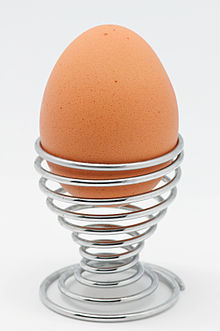
Chef Heston Blumenthal, after "relentless trials", published a recipe for "the perfect boiled egg" suggesting cooking the egg in water that starts cold and covers the egg by no more than a millimeter, removing the pan from the heat as soon as the water starts to bubble. After six minutes, the egg will be ready.[3]
Soft-boiled eggs are not recommended by the Food and Drug Administration for people who may be susceptible to salmonella, such as very young children, the elderly, and those with weakened immune systems.[4] To avoid the issue of salmonella, eggs can be pasteurised in shell at 57 °C for an hour and 15 minutes. The eggs can then be soft-boiled as normal.[5]
Soft-boiled eggs are commonly served in egg cups, where the top of the egg is cut off with a knife, spoon, spring-loaded egg topper, or egg scissors, using an egg spoon to scoop the egg out. Other methods include breaking the eggshell by tapping gently around the top of the shell with a spoon.[6] Soft-boiled eggs can be eaten with toast cut into strips, which are then dipped into the runny yolk. In the United Kingdom and Australia, these strips of toast are known as "soldiers".[7]
In Southeast Asia, a variation of soft-boiled eggs known as half-boiled eggs are commonly eaten at breakfast. The major difference is that, instead of the egg being served in an egg cup, it is cracked into a bowl to which dark or light soy sauce or pepper are added. The egg is also cooked for a shorter period of time resulting in a runnier egg instead of the usual gelatin state and is commonly eaten with kaya toast, Kopi O, or Milo chocolate milk.
Boiled eggs are also an ingredient in various Philippine dishes, such as embutido, pancit, relleno, galantina, and many others.
In Japan, marinated soft-boiled eggs are commonly served alongside ramen. The eggs are typically steeped in a mixture of soy sauce, mirin, and water after being boiled and peeled.[8] This provides the egg a brownish color that would otherwise be absent from boiling and peeling the eggs alone. Once the eggs have finished steeping, they are served either in the soup or on the side.
Hard-boiled eggs
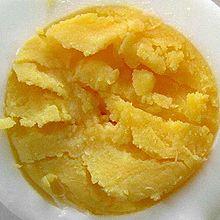

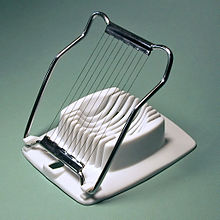
Hard-boiled eggs are boiled long enough for the yolk to solidify (about 10 minutes).[9] They can be eaten warm or cold. Hard-boiled eggs are the basis for many dishes, such as egg salad, cobb salad and Scotch eggs, and may be further prepared as deviled eggs.
There are several techniques for hard-boiling an egg.[10] One method is to bring water to a boil and cook for ten minutes.[11] Another method is to bring the water to a boil, but then remove the pan from the heat and allow eggs to cook in the gradually cooling water.[9][12] Over-cooking eggs will typically result in a thin green iron(II) sulfide coating on the yolk,[13] though the coating has been reported as having little effect on flavor.[2] This reaction occurs more rapidly in older eggs as the whites are more alkaline.[14] Immersing the egg in cold water after boiling is a common method of halting the cooking process to prevent this effect.[12][1] It also causes a slight shrinking of the contents of the egg.

Hard-boiled eggs should be used within two hours if kept at room temperature or can be used for a week if kept refrigerated and in the shell.[15][16][17][18]
Hard-boiled eggs are commonly sliced, particularly for use in sandwiches. For this purpose specialized egg slicers exist, to ease slicing and yield even slices. For consistent slice sizes in food service, several eggs may have their yolk and white separated and poured into a cylindrical mold for stepwise hard-boiling, to produce what is known as a "long egg" or an "egg loaf". Commercial long eggs are produced in Denmark by its inventor Danæg and in Japan by KENKO Mayonnaise. The machine for producing long eggs was first introduced in 1974.[19] In addition to being sliced, long eggs can also be used in their entirety in gala pies.[20]
Other variations

- Piercing
- Some pierce the shell beforehand with an egg piercer to prevent cracking. Ekelund [who?] et al. in Why eggs should not be pierced claimed that pricking caused egg white proteins to be damaged and was therefore to be discouraged. Others, including the American Egg Board, recommend against this, as it can introduce bacteria and create hairline cracks in the shell through which bacteria can enter the egg.[note 1]
- Steaming
- Eggs can be taken straight from the refrigerator and placed in the steamer at full steam.[21]
- Sous vide
- Boiled eggs can be made by cooking/coddling in their shell "sous vide" in hot water at steady temperatures anywhere from 60 to 85 °C (140 to 185 °F). The outer egg white cooks at 75 °C (167 °F) and the yolk and the rest of the white sets from 60 to 65 °C (140 to 149 °F).[22][23]
- Baked eggs
- Baking eggs in an oven instead of boiling in water.
- Salted eggs
- In China, eggs (particularly duck eggs) may be preserved by packing them in salt and charcoal or brine. The salted egg is then boiled or steamed prior to consumption. The process is related to century eggs, which are preserved for a long period and are not boiled.[24]
Peeling
Boiled eggs can vary widely in how easy it is to peel away the shells. In general, the fresher an egg before boiling, the more difficult it is to separate the shell cleanly from the egg white.[25] As a fresh egg ages, it gradually loses both moisture and carbon dioxide through pores in the shell; as a consequence, the contents of the egg shrink and the pH of the albumen becomes more basic. Albumen with higher pH (more basic) is less likely to stick to the egg shell, while pockets of air develop in eggs that have lost significant amounts of moisture, also making eggs easier to peel.
Keeping the cooked eggs soaked in water helps keep the membrane under the egg shell moisturized for easy peeling. Peeling the egg under cold running water is an effective method of removing the shell. Starting the cooking in hot water also makes the egg easier to peel.[25]
It is often claimed that steaming eggs in a pressure cooker makes them easier to peel.[26] Double blind testing has failed to show any advantage of pressure cooking over steaming, and has further shown that starting boiling in cold water is counterproductive. Shocking the eggs by rapidly cooling them helped, and cooling them in ice water for 15 minutes or longer gave more successful peeling. Shocking was also found to remove the dimple in the base of the egg caused by the air space.[27]
Dishes featuring boiled eggs
Boiled eggs often form part of larger, more elaborate dishes. For example, a boiled egg may garnish a bowl of ramen (often first marinated in soy sauce), be baked into a pie such as a torta pasqualina,[28] or be encased in aspic (similar to the French dish œufs en gelée, which features poached eggs[29]), be chopped and mixed with mayonnaise to form egg salad, or be deep-fried and then baked within a serving of lamprais.[30]

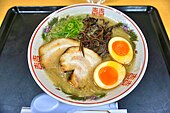
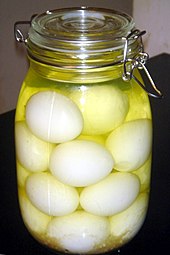
See also
Notes
- ^ The American Egg Board, an industry group, recommends against piercing shells on food safety grounds: "Piercing shells before cooking is not recommended. If not sterile, the piercer or needle can introduce bacteria into the egg. Also, piercing creates hairline cracks in the shell through which bacteria can enter after cooking.", Basic Hard-Cooked Eggs Archived 2 January 2010 at the Wayback Machine, American Egg Board
References
- ^ a b Sci Bytes (18 July 2018). "Why do eggs "hard-boil?"". Nature.
- ^ a b Toops 2014, p. 26.
- ^ Blumenthal, Heston (12 November 2014). "Series: The Do Something expert Index How to boil an egg, the Heston Blumenthal way". The Guardian. Retrieved 12 November 2014.
- ^ "Plan Under Way to Help Lessen Risks from Contaminated Eggs". FDA Consumer magazine. Archived from the original on 11 March 2007. Retrieved 19 December 2006.
- ^ Schuman, J.D.; Sheldon, B.W.; Vandepopuliere, J.M.; Ball Jr, H.R. (2003). "Immersion heat treatments for inactivation of Salmonella enteritidis with intact eggs". Journal of Applied Microbiology. 83 (4): 438–444. doi:10.1046/j.1365-2672.1997.00253.x. PMID 9351225. S2CID 22582907.
- ^ "Fine Manners for Fine Dining". Retrieved 19 December 2006.
- ^ "Egg with Toast Soldiers". Archived from the original on 4 March 2010. Retrieved 22 April 2008.
- ^ "Ajitsuke tamago". Immi Eats. Retrieved 24 July 2024.
- ^ a b "Soft-Cooked Eggs, Medium-Cooked Eggs, and Hard-Cooked Eggs". Retrieved 20 March 2008.
- ^ Seehusen, Joachim (30 March 2021). "Oppskrift på perfekt kokt egg". Tu.no (in Norwegian). Teknisk Ukeblad. Archived from the original on 30 March 2021.
- ^ "How long to Boil Eggs". Eatbydate.com. 19 January 2012.
- ^ a b "The Egg Files Transcript". Archived from the original on 19 March 2022. Retrieved 20 May 2007.
- ^ Belle Lowe (1937), "The Formation Of Ferrous Sulfide In Cooked Eggs", Experimental Cookery From The Chemical And Physical Standpoint, John Wiley & Sons
- ^ Harold McGee (2004), McGee on Food and Cooking, Hodder and Stoughton
- ^ "Learn More About Eggs". Archived from the original on 22 August 2008. Retrieved 19 December 2006.
- ^ "Egg-ucation". Retrieved 19 December 2006. – suggests boiled eggs can be stored refrigerated for one week
- ^ "About Eggs". Archived from the original on 7 November 2006. Retrieved 19 December 2006. – suggests boiled eggs can be stored refrigerated 2–3 weeks
- ^ "Shell Eggs from Farm to Table". Fact Sheets: Egg Products Preparation. United States Department of Agricultural Food Safety and Inspection Service. 20 April 2011. Archived from the original on 26 January 2013. Retrieved 12 January 2013.
When shell eggs are hard cooked, the protective coating is washed away, leaving bare the pores in the shell for bacteria to enter and contaminate it. Hard-cooked eggs should be refrigerated within 2 hours of cooking and used within a week.
- ^ Pollack, Hilary; Sen, Mayukh (22 January 2018). "I Am Mystified and Horrified By the Long Egg". Munchies. Retrieved 28 April 2019.
- ^ "Call For Submissions: The Long Egg". FreakyTrigger. 18 August 2006.
- ^ Bauer, Elsie. "How to Steam Hard Boiled Eggs". www.simplyrecipes.com.
- ^ "Important Cooking Temperatures". Edinformatics.com. 17 November 2006. Retrieved 11 June 2013.
- ^ Vega, César; Mercadé-Prieto, Ruben (2011). "Culinary Biophysics: On the Nature of the 6X°C Egg". Food Biophysics. 6 (1): 152–9. doi:10.1007/s11483-010-9200-1. S2CID 97933856.
- ^ Toops 2014, pp. 28–30.
- ^ a b López-Alt, J. Kenji. "The Food Lab: The Hard Truth About Boiled Eggs". Serious Eats. Retrieved 6 August 2014.
- ^ Eggs Under Pressure Archived 10 August 2020 at the Wayback Machine By Mr. Brown. Published on 18 March 2016.
- ^ How to Make Perfect Hard-Boiled Eggs | The Food Lab. Seriouseats.com (29 July 2020). Retrieved on 2021-06-29.
- ^ "Giant Green Pie (Torta Pasqualina)". The New York Times. Retrieved 10 November 2019.
- ^ Beck, Simone; Bertholle, Louisette; Child, Julia (1964). Mastering The Art Of French Cooking. New York: Alfred A. Knopf. p. 547.
- ^ "The Lamprais Legacy". Sunday Observer. 7 January 2018. Retrieved 2 May 2021.
Sources
- Toops, Diane (15 April 2014). Eggs: A Global History. Reaktion Books. ISBN 978-1-78023-311-6.
